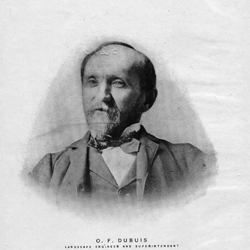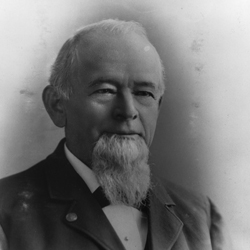The Immigrants Who Helped Build Peoria

Hailing from Switzerland, Italy, Hungary, France and beyond, a wide range of immigrants made their mark on Peoria.
Peoria is a much richer community because of the contributions of our immigrant populations: from the oft-told tales of the Irish building railroads and digging canals, to more recent stories of the families from Itoo, Lebanon, who continue to contribute to the economics, real estate, politics and progress of our region. But there are many lesser-known stories buried in Springdale Cemetery, stories of struggling immigrants whose contributions are still seen in this city’s street names, sculptures and parks, as well as the good works of their descendants. Here are a few of those tales…
Oscar Dubuis
Born in Canton Vaud, Switzerland in 1849, Dubuis immigrated to America in 1870, first settling in Chicago, where he helped to build Humboldt, Grant, Douglas and Lincoln parks. When Daniel Burnham created the “Great White City,” the site for the Colombian Exposition of 1893, Dubuis worked with Frederick Law Olmsted to make his vision a reality. It was then that he began to work with native plants, trees, flowers, grasses and shrubs. As he later wrote in a Peoria Park District report, “Why plant an exotic flower or tree that will not thrive in our harsh winters or dry summers? The native plants are the ones that will thrive here.” Indeed, the great oaks of Peoria have survived for more than 500 years. Dubuis also helped to preserve the virgin oak savannah of Springdale Cemetery. This small patch of prairie is more than half of the entire dry-mesic savannah left in the state of Illinois.
It was also in 1893 that Peoria’s Park Board decided to hire a landscape architect and offered Dubuis the job. His first task was to convert Birkett Hollow into Glen Oak Park. He designed the pavilion, tennis courts and ball fields as a focal point, with all lanes leading to these features. These improvements did not detract from the natural beauty of the site, but greatly enhanced it. Later, he added pavilions and paths to Bradley and Trewyn parks, then began work on Grand View Drive.
It was a hand-dug road, and every effort was made to preserve the old trees along the way, as it takes 200 years to replace a 200-year-old tree. Dubuis’ goal was to give the rider a leisurely ascent where every turn revealed a grander view of the Illinois River below. His vision found fruition when Teddy Roosevelt proclaimed Grand View Drive to be “the world’s most beautiful drive.”
 Joseph Petarde
Joseph Petarde
Born Joseph Petardi in Rome, Italy, in 1866, he came from a family that began carving stone during the days of the Italian Renaissance. At the age of five, he started sculpting, and his father took notice of his efforts and put him to work. At 13, while carving a marble figure, he disfigured it. Fearing his father’s disappointment, he fled to North Africa. He was gone for six months!
At 17, Petarde went to France, where he carved sculptures of saints and angels in cathedrals throughout Paris. However, he struggled to make ends meet, and eventually found his way to New York. While working for a bridge building company, he was sent to Peoria to span the Illinois River with the Upper Free Bridge, the remnants of which still stand near the McClugage Bridge. The land for this project was donated by Captain Alexander Partridge, and Petarde married his daughter, Hannah.
As his family grew, Petarde moved to 623 Fairholm Avenue, where he and his son carved statues of Atlas and semi-nude women to adorn the corners of his porch. In protest, his wife refused to use the front door! The house is still there in Averyville, and is worth wandering past.
Father and son continued working together, and today, their sculptures dot the map of central Illinois, from Peoria’s GAR Hall and the Dime Savings and Trust Company to the old courthouse and post office, as well as many monuments within the grounds of Springdale Cemetery.
Jacob & Hannah Szold
Jacob and Hannah Szold, along with their cousins, Joseph and Hannah Szold, emigrated from Nemiskert, Hungary. Like many immigrants, they came to escape persecution and seek religious freedom, with nothing but hope for a better world. Arriving in Peoria in the 1840s, they helped to establish a synagogue in 1859, which was named Anshai Emeth, or “Men of Truth.” This tight-knit community looked out for one another. Jacob found a job as a watchman at the Woolner Distilling Co, which was also founded by Hungarian immigrants. The family had eight children and practiced what their parents taught them: tzedaka, to give to others, and tikkun olam, to repair the world and leave it a better place than when you came.
One daughter, Ruby, became a teacher at McKinley School. A son, Ira, and his wife, Sophie, started an auto parts store, and they always found a way to help those in need. Ira and Sophie lived on Columbia Terrace, and after discovering that their and their neighbors’ basements would flood every time it rained, Ira went to the city council and convinced it to put in a sewer system for the entire neighborhood. During the Depression, they took their children to the bread lines to give out food, and they helped folks find jobs so they could eat for more than a day. Today, their great-great granddaughter continues training people to find jobs and self-respect. L'dor v' dor—“From generation to generation!”
In 1880, Jacob's cousin, Joseph, with his brother-in-law, Phil Eisler, started Szold's Department Store on Tyng Street, which operated for 106 years. As Peoria grew, their friends urged them to move north, but they stayed. There was nowhere else for folks to shop, and they could provide jobs for the neighborhood. Later, Joseph's grandsons, Jack and Arthur, both presided over community organizations like the Peoria Symphony and the Civic Center, and the Szold family helped to build the B'nai Brith retirement home.
Another cousin, Henrietta, the daughter of a rabbi, became a scholar and went on to found Hadassah. Today, it is one of the largest women's organizations in the United States, with chapters located all over the world, dedicated to providing healthcare and assistance to the most needy… tikkun olam—“repair the world.”
 Henry Detweiller
Henry Detweiller
Henry Detweiller was born in the Alsace-Lorraine region of France in 1825. His father was a wealthy farmer and miller, and at one time, both French and German royalty dined at one of the Detweiller family’s three estates. But after Napoleon waged war across Europe, Henry’s father lost everything and died destitute. In 1837, the family came to Peoria, where an older brother ran the St. Croix Tavern on Water Street. While washing dishes in the tavern, where many a steamboat captain were frequent customers, Henry Detweiller’s dream was born.
Detweiller became a cub pilot on a boat named the Frontier. One day, while coming up through the narrows of the river, another steamboat, the Panama, ran into him. Thinking quickly, Detweiller ran the Frontier aground, striving for the shore, and all 51 of its passengers survived. The following spring, a new boat was built, and the owners hired Detweiller as pilot because of the way he kept his cool in a crisis. In 1857, he bought his own boat, the Minnesota, and traveled up and down the Mississippi and Illinois rivers, from St. Paul all the way to New Orleans. Abraham Lincoln was a frequent passenger aboard the Minnesota, and Detweiller ferried him here for his last visit to our fair city. During the Civil War, Detweiller transported troops and supplies wherever they were needed, running dangerous missions as far south as Natchez. He continued as a pilot until 1874.
After his stint on the river, Detweiller built a fortune on land in the ice business, constructing a warehouse and establishing Detweiller Ice, a company that cut and stored 21 million pounds of ice every winter. When Henry passed away, his son, Thomas, took over the family business.
The Detweiller children bought land along the river and donated it to the city, naming it Detweiller Park in honor of their father. They also established a trust fund, money that is still in the bank today, to help pay for the park’s maintenance. After the ice business fizzled, the property downtown was converted to a public marina, Detweiller Marina, so future generations can still have access to Detweiller’s beloved Illinois River. iBi
Photos courtesy of Peoria Historical Society, Special Collections Center, Bradley University Library

